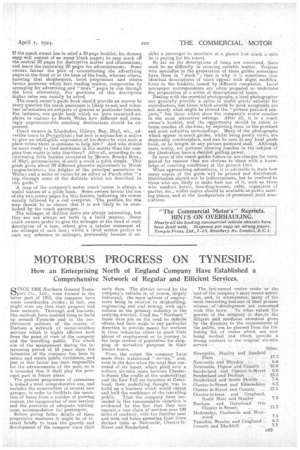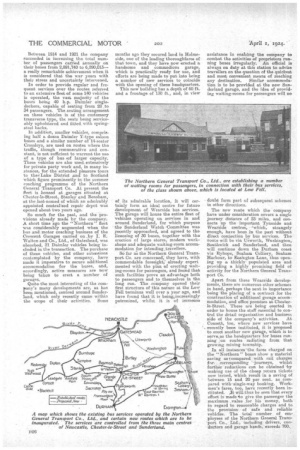MOTORBUS PROGRESS ON TYNESIDE.
Page 19

Page 20

If you've noticed an error in this article please click here to report it so we can fix it.
SINCE THE Northern General Transport Co., Ltd., were foamed in. the latter pert of 1913, the company have made considerable strides; in fact, one might even say that their progress had been meteoric. Thorough and businesslike methods have enabled them to build up around Tyneside and in the northernmost portions of the celerity of Durhamu a network of motor-omnibus services which is highly efficient both from the point of view of the company and the travelling public. The whole aim of the management during the intervening period of 10 years since the formation of the company has been to secure and retain public confidence, and just as this factor has been responsible for the advancements of the past, so is it intended that it shall play the prin.eipal part in future plans.
The present programme of extensions is indeed a most comprehensive one, and includes the construdtion of several new garages, in order to facilitate the operalien of buses from a number of growing centree, the inauguration of new services and the provision of adequate waitingroom accommodation for passengers.
Befere giving fuller details of these progressive measures it might he of interest briefly' to trace the growth and development of the company' since their early days. The district served by the company's vehicles is, of course, largely industrial, the main spheres of employment being in relation to shipbuilding, engineering and coal mining, with agriculture as the primary industry in the outlying districts. Until the "Northern buses were put on the reed no definite efforts had been made in any particular direction to provide means for workers in thee industries either to reach their places of employment or to , journey, to the large centres of popuraticin for shopping or recreative purposes in their leisure hours.
From the outset the company, have made their watchword ".serelee, ! and, even in the days when the total fleet consisted of six buses, which plied aver a solitary six-mile route between Chesterle-Street (the cradle of the, undertaking) and the Low Fell ear terminus at Gateshead, their Underlyingthought was to build up e business which would 'obtain and hold the confidence of the travelling public. , That The company have succeeded in this commendable objective is evidenced by the fact that they now operate a vast chain of services over 120 miles of roadway, with the familialneat arid trim red buses operating from three distinct hubs at Newcastle, Chester-leStreet and Sunderland. The last-named centre ranks as the 'Mit of the company's most recent activities, and, an consequence, many of the 'most interesting features of their present scheme 'of development are concerned with this town. To what extent the growth of the company is dueeto the diligent and assiduous attention given by the directors to the requirements of the public, can he gleaned from. the following list of. reetee which are now being worked and which provide a strong contrast to the original six-mile service.-
Miles. Newcastle, Stanley and Annfield Plain „. ... 17.5 Newcastle and Bleyden ... 5.4 Newcastle, Dipton and Consett 15.0 Sunderland and Chester-le-Street 9.0 Sunderland and Durham 13.3 Sunderland and South hield ... 7.4 Cheater-le-Street and Edmondsley .5.3 Chester-le-Street and Consett ... 12.3 Chester-le-treet .. and Craghead, South Moor and Stanley ... 7.5 Durham and Gateshead (via Chester-le-Street) ... 13.3 Medemsley, Castleeicle and West Tentobie, Stanley and Craghead... 4.3 Consete and Blackhill ... 3.5 Between 1914 and 1921 the company succeeded in increasing the total number of passengers carried annually on their buses from 2,891,740 to 6,290,013a really remarkable achievement when it is considered that the war years with their stress and uncertainty intervened.
In order to provide regular and frequent services over the routes referred to an extensive fleet of some 140 vehicles is operated, the 'Vast majority of the buses being 40 hip. Daimler single
d eckers, capable of seating from 28 to 34 passengers. The seating arrangement on these vehicles is of the .customary transverse type, this seats' being service'ably upholstered and ritted.with springsteel backs.
In addition, smaller vehicles, comprising half a dozen Daimler Y-type saloon buses and a similar number of 14-seater Crossleyssare used on routes where the traffic, though remunerative and constant, is not sufficient to warrant the use of a type of bus of larger capacity. These vehicles are also used extensively for private party work and, in many instances, for-the extended pleasure tours to thesLake District and to Scotland which figure prominently in the summer coaching programme of the Northern General Transport Co. At present the fleet is housed at .garages situated at Chester-le-Street, Stanley and Bensham, at the. last-named of which an admirably appointed centralized repair depot was opened about tare years ago.
So much for the past, and the • provisions already made by the company. A short time ago the "Northern" fleet was considerably augmented when the bus andeasoter coaching business of the Crescent Garages carried on by L E. Walton and Co., Ltd., of Gateshead, was absorbed, 21 Daimler vehicles being included in the transaction. The purchase of these vehicles, and other extensions contemplated lay the company, have made it imperative to secure additional accommodation for the buses, and, accordingly, active measures are now being taken to erect a number of garages.
Quite the most interesting of the company's many developments are, as has been mentioned, centred around Sunderland, which only recently came within the 'scope of their activities. Some
months ago they secured land in Helmsside, one of the leading thoroughfares of that town, and they have now erected a handsome and commodious garage, which is practically ready for use, and efforts are being made to put into being a number of new services to coincide with the opening of these headquarters.
This new building has a depth of 60 ft. and a frontage of 130 ft., and, in view of its admirable location, it will certainly form, an ideal centre for future development of Wearside bus services. The garage will house the entire fleet of vehicles operating on services in and around _Sunderland, for which purpose the Sunderland Watch -Committee was recently approached, and agreed to the licensing of 30 buses, together with the erection of large stores, modern work• shops and adequate waiting-room accommodation for intending,travellers.
So far as the Northern General Transport Co. are concerned, they have, with commendable foresight,' already experi rnented with the plan of ereeting waiting-ro•oms for passengers, and found that such facilities prove an advantage both to passengers and to themselves in the long run. The comPany opened their first structure of this nature at the Low Fell terminus welt over a year ago, and have found that it is being; increasingly patronized, whilst it is of immense
assistance in enabling the company to combat the activities of proprietors running buses irregularly-. An official is always on duty at this station to advise travellers on the question of the quickest and most convement means of reaching any destination. Similar accommodation is to be provided at the new Sunderland garage, and the idea of providing waiting-rooms for passengers will no
• doubt form part of subsequent schemes in other directions.
The new route which the company have under consideration covers a single journey distance of 23 miles, and connects up the • important Tyneside and Wearside centres, "which, strangely enough, have been in the past without direct connection by bus services. The' route will be via bisworth, Washington, SouthwiCk and Sunderland, and then will continue down the Durham coast via Byhope, Seahana Colliery, Seaham Harbour, to Easisgton Lane, thus opening up a thickly populated area and providing a highly promising field of activity for the Northern General Transport Co.
Apart from these Wearside developments, there are numerous other schemes in hand, perhaps the next in importance being the placing of a contract for the construction of additional garage accommodation, and office premises at Chesterle-Street. These are being erected in order -to house the staff essential to control the detail organization and business
side of the company's activities. At Consett, too, where new services have recently been instituted, it is proposed to erect another new garage, which is to serva.as the headquarters for buses running on routes radiating from that growing mining township.
In all instances'the fares charged on the "Northern" buses show amaterial saving as icompared. with rail charges Inn . corresponding 'journeys, whilst further reductions can be obtained by making use of the cheap return tickets now issued, which result in a saving a between 15 and 20 per cent. as compared with-single-way booking. Workmen's fares, too, have recently been in stituted. ,It thus be seen that every effort is made to give the passenger the maximum .value for his money, both in regard to reasonable charges and to the provision • of safe and reliable vehicles. The total' number of employees of the Northern General Trans. Co., Ltd., including drivers, 'Conductors and garage hands,. exceeds 700.,






















































